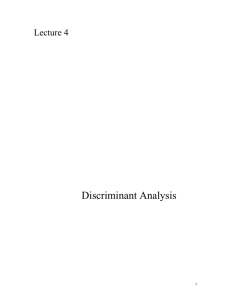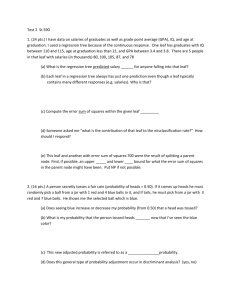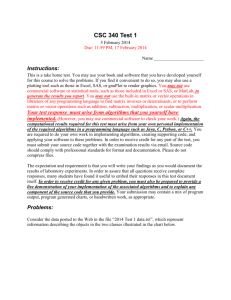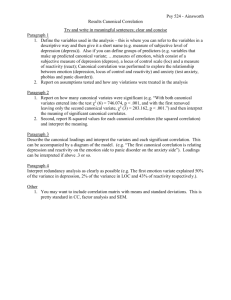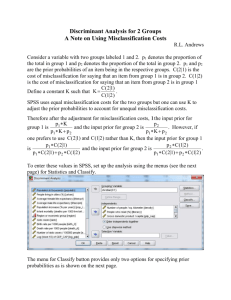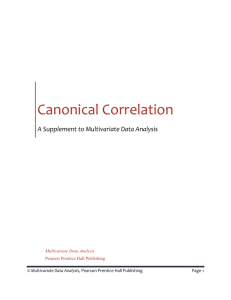Lecture 4
advertisement
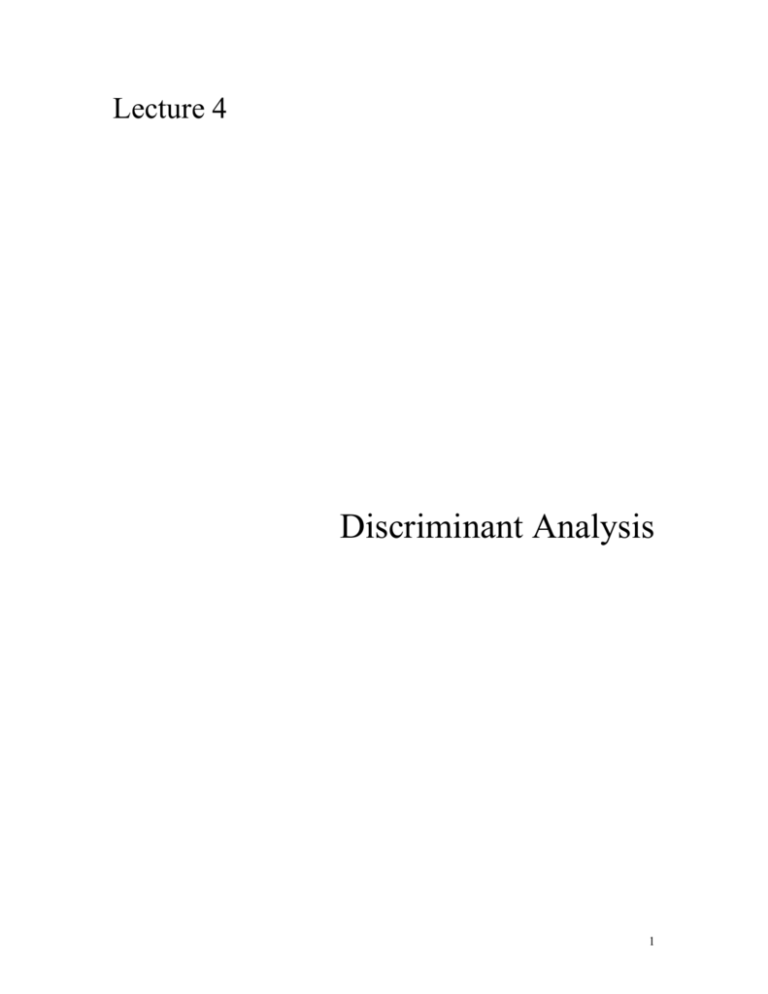
Lecture 4
Discriminant Analysis
1
Discriminant analysis uses continuous variable measurements on different groups of
items to highlight aspects that distinguish the groups and to use these measurements to
classify new items. Common uses of the method have been in biological classification
into species and sub-species, classifying applications for loans, credit cards and insurance
into low risk and high risk categories, classifying customers of new products into early
adopters, early majority, late majority and laggards, classification of bonds into bond
rating categories, research studies involving disputed authorship, college admissions,
medical studies involving alcoholics and non-alcoholics, anthropological studies such as
classifying skulls of human fossils and methods to identify human fingerprints.
Example 1 (Johnson and Wichern)
A riding-mower manufacturer would like to find a way of classifying families in a city
into those that are likely to purchase a riding mower and those who are not likely to buy
one. A pilot random sample of 12 owners and 12 non-owners in the city is undertaken.
The data are shown in Table I and plotted in Figure 1 below:
Table 1
2
Figure 1
We can think of a linear classification rule as a line that separates the x1-x2 region into
two parts where most of the owners are in one half-plane and the non-owners are in the
complementary half-space. A good classification rule would separate out the data so that
the fewest points are misclassified: the line shown in Fig.1 seems to do a good job in
discriminating between the two groups as it makes 4 misclassifications out of 24 points.
Can we do better?
We can obtain linear classification functions that were suggested by Fisher using
statistical software. You can use XLMiner to find Fisher’s linear classification functions.
Output 1 shows the results of invoking the discriminant routine.
3
Output 1
Prior Class Probabilities
Classification Functions
Canonical Variate Loadings
Training Misclassification Summary
We note that it is possible to have a misclassification rate that is lower (3 in 24) by using
the classification functions specified in the output. These functions are specified in a way
that can be easily generalized to more than two classes. A family is classified into Class 1
of owners if Function 1 is higher than Function 2, and into Class 2 if the reverse is the
case. The values given for the functions are simply the weights to be associated with each
4
variable in the linear function in a manner analogous to multiple linear regression. For
example, the value of the Classification function for class1 is 53.20. This is calculated
using the coefficients of classification function1 shown in Output 1 above as –73.1602 +
0.4296 60 + 5.4667 18.4. XLMiner computes these functions for the observations in
our dataset. The results are shown in Table 3 below.
Table 3
Notice that observations 1, 13 and 17 are misclassified as we would expect from the
output shown in Table 2.
Let us describe the reasoning behind Fisher’s linear classification rules. Figure 3 depicts
the logic.
5
Consider various directions such as directions D1 and D2 shown in Figure 2. One way to
identify a good linear discriminant function is to choose amongst all possible directions
the one that has the property that when we project (drop a perpendicular line from) the
means of the two groups onto a line in the chosen direction the projections of the group
means (feet of the perpendiculars, e.g. P1 and P2 in direction D1) are separated by the
maximum possible distance. The means of the two groups are:
Mean1
Mean2
Income
79.5
57.4
Area
20.3
17.6
We still need to decide how to measure the distance. We could simply use Euclidean
distance. This has two drawbacks. First, the distance would depend on the units we
choose to measure the variables. We will get different answers if we decided to measure
area in say, square yards instead of thousands of square feet. Second , we would not be
taking any account of the correlation structure. This is often a very important
consideration especially when we are using many variables to separate groups. In this
case often there will be variables which by themselves are useful discriminators between
groups but in the presence of other variables are practically redundant as they capture the
same effects as the other variables.
Fisher’s method gets over these objections by using a measure of distance that is a
generalization of Euclidean distance known as Mahalanobis distance. This distance is
defined with respect to a positive definite matrix∑ . The squared Mahalanobis distance
6
between two p-dimensional (column) vectors y1 and y2 is (y1 – y2)’ ∑-1 (y1 – y2) where
is a symmetric positive definite square matrix with dimension p. Notice that if ∑ is the
identity matrix the Mahalanobis distance is the same as Euclidean distance. In linear
discriminant analysis we use the pooled sample variance matrix of the different groups. If
X1 and X2 are the n1 x p and n2 x p matrices of observations for groups 1 and 2, and the
respective sample variance matrices are S1 and S2, the pooled matrix S is equal to
{(n1-1) S1 + (n2-1) S2}/(n1 +n2 –2). The matrix S defines the optimum direction
(actually the eigenvector associated with its largest eigenvalue) that we referred to when
we discussed the logic behind Figure 2. This choice of Mahalanobis distance can also be
shown to be optimal* in the sense of minimizing the expected misclassification error
when the variable values of the populations in the two groups (from which we have
drawn our samples) follow a multivariate normal distribution with a common covariance
matrix. In fact it is optimal for the larger family of elliptical distributions with equal
variance-covariance matrices. In practice the robustness of the method is quite
remarkable in that even for situations that are only roughly normal it performs quite well.
If we had a prospective customer list with data on income and area, we could use the
classification functions in Output 1 to identify the sub-list of families that are classified as
group 1. This sub-list would consist of owners (within the classification accuracy of our
functions) and therefore prospective purchasers of the product.
Classification Error
What is the accuracy we should expect from our classification functions? We have an
training data error rate (often called the re-substitution error rate) of 12.5% in our
example. However this is a biased estimate as it is overly optimistic. This is because we
have used the same data for fitting the classification parameters as well for estimating the
error. In data mining applications we would randomly partition our data into training and
validation subsets. We would use the training part to estimate the classification functions
and hold out the validation part to get a more reliable, unbiased estimate of classification
error.
So far we have assumed that our objective is to minimize the classification error and that
the chances of encountering an item from either group requiring classification is the
same. . If the probability of encountering an item for classification in the future is not
equal for both groups we should modify our functions to reduce our expected (long run
average) error rate. Also we may not want to minimize misclassifaction rate in certain
situations. If the cost of mistakenly classifying a group 1 item as group 2 is very different
from the cost of classifying a group 2 item as a group 1 item, we may want to minimize
the expect cost of misclassification rather than the error rate that does not take cognizance
of unequal misclassification costs. It is simple to incorporate these situations into our
framework for two classes. All we need to provide are estimates of the ratio of the
__________________________
* This is true asymptotically, i.e. for large training samples. Large training samples are
required for S, the pooled sample variance matrix, to be a good estimate of the population
variance matrix.
7
chances of encountering an item in class 1 as compared to class 2 in future classifications
and the ratio of the costs of making the two kinds of classification error. These ratios will
alter the constant terms in the linear classification functions to minimize the expected
cost of misclassification. The intercept term for function 1 is increased by ln(C(2|1)) +
ln(P(C1)) and that for function2 is increased by ln(C(1|2)) + ln(P(C2)), where C(i|j) is the
cost of misclassifying a Group j item as Group i and P(Cj) is the apriori probability of an
item belonging to Group j.
Extension to more than two classes
The above analysis for two classes is readily extended to more than two classes. Example
2 illustrates this setting.
Example 2: Fisher’s Iris Data This is a classic example used by Fisher to illustrate his
method for computing clasification functions. The data consists of four length
measurements on different varieties of iris flowers. Fifty different flowers were measured
for each species of iris. A sample of the data are given in Table 4 below:
Table 4
8
The results from applying the discriminant analysis procedure of Xlminer are shown in
Output 2:
Output 2
Classification Functions
Canonical Variate Loadings
Training Misclassification Summary
9
For illustration the computations of the classification function values for observations 40
to 55 and 125 to 135 are shown in Table 5.
Table 5
10
Canonical Variate Loadings
The canonical variate loadings are useful for graphical representation of the discriminant
analysis results. These loadings are used to map the observations to lower dimensions
while minimizing loss of “separability information” between the groups.
Fig. 3 shows the canonical values for Example 1. The number of canonical variates is the
minimum of one less than the number of classes and the number of variables in the data.
In this example this is Min( 2-1 , 2 ) = 1. So the 24 observations are mapped into 24
points in one dimension ( a line). We have condensed the separability information into 1
dimension from the 2 dimensions in the original data. Notice the separation line between
the x values and the mapped values of the misclassified points.
In the case of the iris we would condense the separability information into 2 dimensions.
If we had c classes and p variables, and Min(c-1,p) > 2 , we can only plot the first two
canonical values for each observation. In such datasets sometimes we still get insight into
the separation of the observations in the data by plotting the observations in these two
coordinates
11
Extension to unequal covariance structures
When the classification variables follow a multivariate normal distribution with variance
matrices that differ substantially between different groups, the linear classification rule is
no longer optimal. In that case the optimal classification function is quadratic in the
classification variables. However, in practice this has not been found to be useful except
when the difference in the variance matrices is large and the number of observations
available for training and testing is large. The reason is that the quadratic model requires
many more parameters that are all subject to error to be estimated. If there are c classes
and p variables, the number of parameters to be estimated for the different variance
matrices is cp(p + 1)/2. This is an example of the importance of regularization in practice.
Logistic discrimination for categorical and non-normal situations
We often encounter situations in which the classification variables are discrete, even
binary. In these situations, and where we have reason to believe that the classification
variables are not approximately multivariate normal, we can use a more generally
applicable classification technique based on logistic regression.
12

